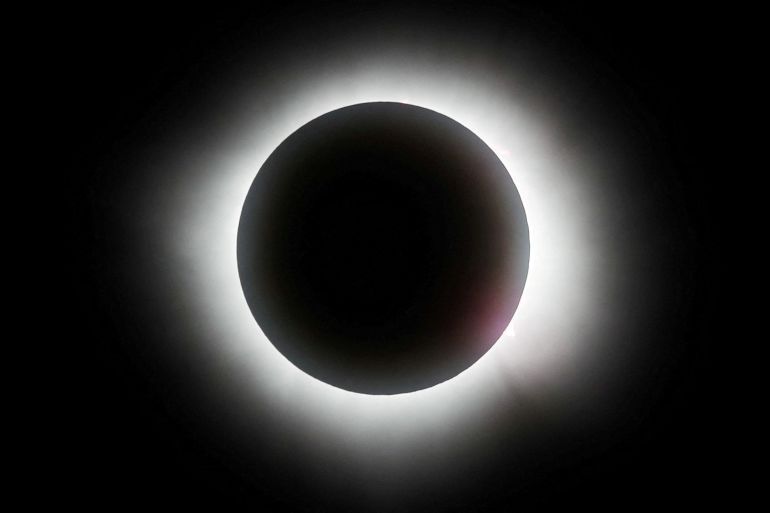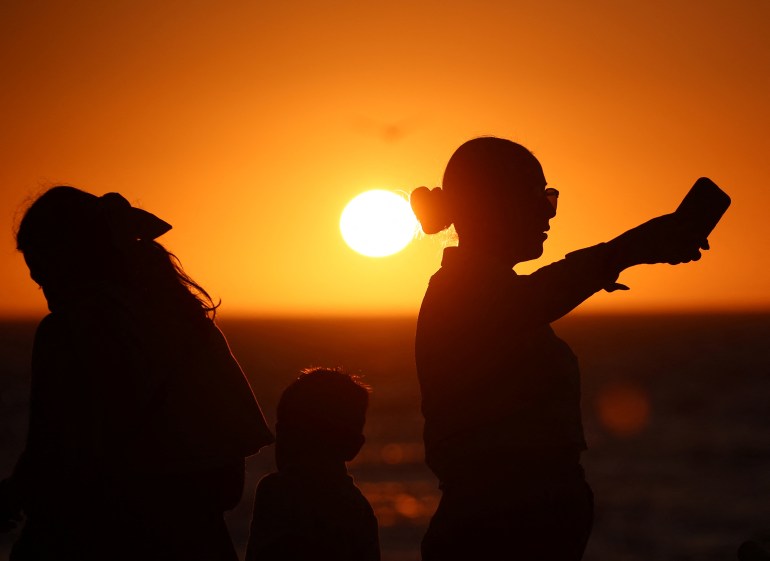Total solar eclipse frenzy grips North America
The eclipse will be visible along a path starting in Mexico and then crossing through the US and into Canada.

Millions of people in the path of a solar eclipse across North America are gazing towards the heavens as the moon completely blocks the sun for more than four minutes in some areas.
The town of Mazatlan on Mexico’s west coast in was one of the first places to witness the full eclipse on Monday, with thousands of people gathering there to look skywards.
Keep reading
list of 3 itemsSolar eclipse wows stargazers in Indonesia, Australia
In Pictures: Solar eclipse sweeps across Chile and Argentina
Lourdes Corro, 43, was one of the visitors who arrived in Mazatlan especially for the eclipse: She travelled 10 hours by car to get there.
“The last one I saw was when I was 9 years old,” Corro told the Reuters news agency. “There are a few clouds, but we can still see the sun.”
Beyond Mazatlan, the eclipse was visible, weather permitting, along a path starting in Mexico and then crossing through the United States and into Canada.
Eclipse fans across North American have travelled to places along the “path of totality”, where the moon will fully blot out the sun. They include the city of Fredericksburg in central Texas, where the total eclipse occurred shortly after 1:30pm (18:30 GMT).
That is where Michael Zeiler, a veteran eclipse chaser from New Mexico who has already witnessed 11 total eclipses across the globe, set himself up to view the latest one.
“First-time viewers of a total eclipse will be gobsmacked by the sight,” Zeiler said. “It will be a peak life experience.”

At up to four minutes and 28 seconds, this one will last longer than the total eclipse that streaked across parts of the US in 2017, which clocked in at up to two minutes and 42 seconds.
Al Jazeera’s Colin Baker said the four-minute eclipse will be a “data gathering bonanza” for researchers.
“Six hundred high-altitude balloons will be released. A 4km-long kite will point a measuring instrument at the sun. Rockets will launch from an island in Virginia, and jets will take off to fly inside the path of totality — noses open, cameras on,” Baker added.
“With better tools, more smartphones and more research centres under its path, more data will likely be gathered during this total solar eclipse than ever before.”
According to NASA, total eclipses can last anywhere from 10 seconds to about seven-and-a-half minutes.

Other cities in the path of totality include Indianalopolis, Indiana; Erie, Pennsylvania; Cleveland, Ohio; Montreal, Quebec; and major urban centres in Texas like San Antonio, Austin and Dallas. Both Niagara Falls — the city in New York and its counterpart in Ontario — will also experience the full eclipse.
A partial eclipse will be visible in North America outside the path of totality.
About 32 million people in the US live within the path of totality, with federal officials predicting another five million people will travel to be there.
It took about 80 minutes from the moment the moon first began to cover the sun to the moment of totality, then another 80 minutes to complete the process in reverse.
Experts have advised eclipse viewers to use protective solar glasses to prevent eye damage from looking at the sun with the naked eye.
Only during the few minutes of totality can the sun be safely viewed without such glasses, they said.
In the US, several Democratic politicians used the occasion to take a dig at former Republican President Donald Trump, who stared at the sun without protective glasses during a partial eclipse in 2017.
Happy #SolarEclipse Day, CA-12!
Make sure to take proper precautions today by using eclipse viewing glasses (and common sense) 😉😎 pic.twitter.com/PRR2oOpEsp
— Rep. Barbara Lee (@RepBarbaraLee) April 8, 2024